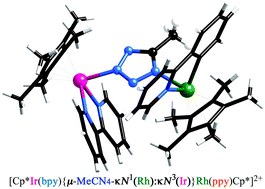Several new iridium(III) and rhodium(III) complexes bearing 5-methyltetrazolate (MeCN4−) have been prepared, and their structures in the crystals and in solution have been determined by X-ray analysis and by NMR spectroscopy, respectively. In the crystals of the mononuclear complexes, κN2-coordination of MeCN4− was observed when the ancillary ligand was 2,2′-bipyridine (bpy): [Cp*M(bpy)(MeCN4-κN2)]PF6 (Cp* = η5-C5Me5; M = Ir: 1 and Rh: 2), while the corresponding complexes with 2-(2′-pyridyl)phenyl (ppy−) were confirmed to have the κN1-coordination of MeCN4−: [Cp*M(ppy)(MeCN4-κN1)] (M = Ir: 3 and Rh: 4). In solution, the IrIII complexes (1 and 3) were robust enough to maintain their molecular structures, but the RhIII complexes (2 and 4) existed as an equilibrium mixture of the κN1- and κN2-isomers. In addition to the IrIII–IrIII and RhIII–RhIII homodinuclear complexes bridged by MeCN4− (5–8), the corresponding heterodinuclear IrIII–RhIII complexes (9–12) were prepared using the mononuclear IrIII complexes (1 and 3) as precursors. The molecular structures of these dinuclear complexes were also characterised. Interestingly, both of the heterodinuclear complexes comprised of Cp*M(bpy)2+ and Cp*M′(ppy)+ fragments, [Cp*M(bpy)(μ-MeCN4)M′(ppy)Cp*](PF6)2 (M = Ir, M′ = Rh: 10 and M = Rh, M′ = Ir: 11), exhibited selective crystallisation of a specific μ-κN1(M′-ppy):κN3(M-bpy) isomer. In solution, the dinuclear complexes with a Rh–N(MeCN4) bond and more than one positive charge (6 and 9–11) showed a dissociation equilibrium, while monocationic MeCN4-bridged complexes (7, 8 and 12) were inactive for dissociation. Furthermore, the heterodinuclear complexes of 9–12, as well as the RhIII–RhIII complex of 8, exhibited a bridging isomerisation, which would proceed via a η2:η2-intermediate without dissociation of Cp*M(bpy or ppy) fragments.


 Please wait while we load your content...
Please wait while we load your content...